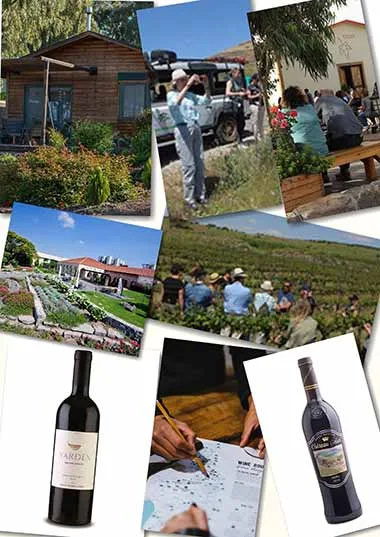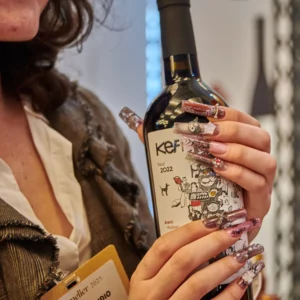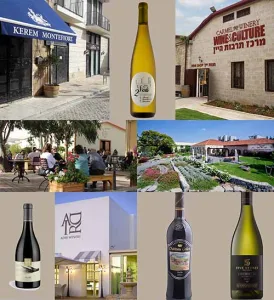When I first came to Israel, there was one wine region that was considered above all others. The Golan Heights with its high elevation, volcanic soil and black basalt stone, was considered perfect for growing grapes with the potential to make high quality wine.
The Golan Heights Winery carried not only the wine hopes of the region, but the whole country. New World winemaking technology, the idea of making wine in the vineyards and the introduction of new varieties made this the pioneering winery.
The close association between winery and growing region, encouraged the winery to promote ‘The Land of Wine’ referring to the Golan. I remember Segev Yerovam, ex CEO of Golan Heights Winery and Galil Mountain Winery, predicting that one day there would be a wine route on the Golan. At that time there was only one winery on the Golan, but Segev, a true Golan patriot, looked into the tea leaves and saw the future.
He was right. Today there are 20 wineries on the Golan Heights ranging from Chateau Golan in the Southern Golan to Mount Odem in the north. There are numerous Best & Breakfasts and Guest Houses. There are things to do, places to see, activities for children and young families, and also for active seniors who have seen everything.
The Golan Heights came to Israel as a result of the 1967 Six Day War. Farming villages were founded and the region soon became known for its apple industry. The first vineyards were planted in 1976 and the Golan Heights Winery was founded in 1983. They made Israel’s first international class wines and by amassing numerous international awards, succeeded in putting Israel on the world wine map.
The first boutique winery on the Golan was Bazelet Ha Golan founded in 1998 by Yoav Levy and Assaf Kedem (now at his own Assaf Winery). Chateau Golan was founded in 1999 and others soon followed.
The Golan Heights is ludicrously regarded as occupied territory by the world. This is ludicrous simply because it is neither occupied, nor is there anyone to give it back to. This represents an example of the world’s blindness where Israel is concerned and also is a massive failure of Israel diplomacy. There is no moral quandary on the Golan. There is no occupation there. There are no Palestinians. Furthermore, if Israel had to give up the Golan, whom would receive it? Maybe the monster President Assad, who is arguably the biggest butcher of the 21st century? He is scarcely an Anwar Sadat or King Hussein! Or perhaps Israel’s greatest enemy Iran is a candidate? They are currently burrowing in to Syria. So, the hypocrisy of the world is at its most biased with regard to the Golan.
For these reasons, I particularly love to explore the rich Jewish history of the Golan. There are numerous old synagogues on there. In fact, about a quarter of all the ancient synagogues found in Israel are situated on the Golan. All the Jewish communities were from, plus or minus, 2,000 years ago. They had three things in common. They community would be situated near a spring bringing fresh water. Each community would have a synagogue, which was the center of the activity. They would also have oil presses which were used to produce and export olive oil. I can certainly recommend the Katzrin Talmudic village and the Gamla archaeological site. Best of all may be the relatively new reconstructed site of Ein Keshatot. Amazingly the structure was rebuilt stone by stone with the use of 3D imaging technology.
I enjoy visiting an archaeological site showing ancient olive oil production, and comparing it, with a modern enterprise. Visit Eretz Geshur Olive Oil and you will see one of Israel’s finest olive oils, produced from their own olive groves and their own olive press. If you want wine history, it is worth visiting the Hippos – Sussita archaeological site, overlooking the Sea of Galilee. There archaeologists have uncovered a sophisticated winery complex.
I believe the Golan Heights is a tourism treasure. It is situated in north east of Israel, overlooking the Sea of Galilee, and overlooked by the snow-covered Mount Hermon. It is a strip, roughly 40 miles long and 12 miles wide. You arrive there and are immediately confronted by a quietness and tranquility that feels as though you are abroad. It is like turning the sound off. You climb sharply from the Sea of Galilee area, where bananas are grown, to the coolest agricultural area in Israel where apples, vines and cherries thrive. You leave the frenetic, non-stop Israel behind. There are numerous places to stay. Take your pick. I myself have experience of Assaf Winery’s Kedem Wine Village near Kidmat Zvi, in the heart of wine country, and Cnaan Village Spa in Had Ness, overlooking the Sea of Galilee. Both are heartily recommended.
My love affair with the Golan is an all year affair. In the winter and spring, it is wonderfully green. Water abounds everywhere. You can follow the water from the beautiful Banias Reserve, passing numerous reservoirs and hop from waterfall to waterfall. Visit only one and it should be the Gamla waterfall, which is the most spectacular. In the summer, the Golan is slightly cooler than the hot and humid coastal area, and in the autumn is the time of the harvest. Enjoy hiking amongst the cattle and horses and I am not giving away a secret, when I tell you a vineyard is the perfect spot for a picnic.
The Golan is covered in vineyards and the Golan Heights is most famous for its wine. Six of the main wineries have combined to produce a wine route. Each contributes something different to the mosaic of Golan wine wineries have joined together. The magnificent slightly regal Chateau Golan, with its grand, pillared, soft lighting cellar is worth a visit. It is situated in Moshav Eliad in the Southern Golan. The winemaker here, Uri Hetz, is an instinctive artist and individualist. His wines are individual expressions of his world view and of his own vineyards. He is a pioneer of the so-called Mediterranean varieties, his Geshem blends are excellent, but he also produces a high quality Sauvignon Blanc, a great Syrah and his Eliad is a truly fine wine, with concentration and balance. I liked tasting the wine on the grass in front of the winery building with the outsize bottle as part of its design. Chateau Golan (non-kosher) is without doubt one of Israel’s finest boutique wineries.
Next on the list would be the Golan Heights Winery (kosher) , the king of the castle This winery has shaped wine in Israel and every winery on the Golan has developed under its shadow. The Golan Heights Winery has won awards at the very highest level for sparkling, white, red and dessert wines, showing a level of international quality, that it has maintained over thirty years and great versatility. The visitors center will make you think of Napa Valley. The winery offers wines at every price point from Mount Hermon Red, the country’s largest selling wine, to Yarden Katzrin, arguably the grandest of all the prestige, de-luxe wines in Israel. Here the tour is a must describing the winegrowing and wine making process and the tasting. The guides are experienced and are able to take you inside the skin of Golan wine country. Lesser known wines which are worth tasting are the Gamla Sangiovese and the Yarden Pinot Gris.
Bazelet Hagolan (kosher) is situated at Moshav Kidmat Zvi. This winery is owned by Yoav Levy. The wines are rich, round, voluptuous, full of fruit and mouth filling flavor. These are probably the most ‘New World’ of the Golan’s wines. The Cabernet Sauvignon is his calling card, and he has a great Chardonnay. I like the area. Woods, horses set the scene before you see his beautiful cellar.
Assaf Winery (non kosher) is also at Kidmat Zvi. This is owned by the Kedem family. Wine grower Assaf Kedem founded his winery and the had the vision to create Israel’s first wine village which is a family affair. Stylish, beautifully fitted cabins, delicious homemade food and a central location, make this the perfect place to stay, or for a pit stop. The winery specializes in varieties Assaf learnt about in South Africa, including Chenin Blanc and Pinotage. The Rujum 91 is also worth a detour. He is a wine tourism pioneer not just of the Golan, but also of Israel.
At Kibbutz Ein Zivan, overlooking Kuneitra, you will find Pelter Winery (non kosher). This was founded by Nir and Tal Pelter in 2001. The wines are sourced from all over Israel and are extremely popular in Israeli restaurants. My favorites are the clean, minerally whites like Sauvignon Blanc, Chardonnay and Chenin Blanc. The place shows a relaxed, laid back atmosphere of a non-kosher winery that has outgrown itself . Here you can lean on a barrel without incurring the wrath and concern of kosher supervisors. (When I used to give a tour of at a kosher winery, I used to say “if you touch it, you have bought it!”) Here, feel free! Home produced goat’s cheese, olive oil, and artisan spirits produced in an authentic pot still (the arak is the best of these), are available. Who said you are only able to buy wine! There is also the Pelter owned Matar Winery on the same premises, but it is closed off to preserve its kosher status.
Tasting wine in the place it is made, possibly with the person who made it, is always a special experience. However, you can better that, if you can drink a wine in the vineyard where its grapes are grown. It is always worthwhile visiting a vineyard or two, because it adds context and only then will you truly understand the Golan terroir. The Ortal vineyard is worth a visit, because it lies right next to the Ortal Winery. It is a true estate winery. Ortal has a very talented new winemaker, who is one of too few women winemakers. Look out for the younger wines, that she herself has made, but there may also be some best buys from the older vintages.
The Avital vineyard inside a disused volcano is always a great and original place for a group photo. Alternatively, Bar’on Vineyard is a great one to visit. It is immaculately kept, with a great view of Mount Hermon. Most important it showcases the pioneering sustainability program of the Golan Heights Winery, whose viticulture technology is amongst the most advanced in the world. There is even a hut and table for a sandwich lunch. If you can arrange an explanation, don’t hesitate, go for it!
The northern most winery in Israel is the Odem Mountain Winery (kosher). It is situated in Moshav Odem and was founded by Michael and Idit Alfasi. This is a homey winery situated 1,100 meters above sea level, considerably closer to Mount Hermon, in the heart of an oak forest. Their son is now the winemaker, though Michael is quick to say that he is “first a grower, and only second a winemaker.” The wines show individuality and character and their Volcani wines are good value. Don’t miss the opportunity to taste their dessert wines which are excellent.
I suggest you always book in advance to avoid disappointment. Wineries will be able to guide you. You will need to appoint a designated driver, or hire a minibus. A jeep tour is a fun way of experiencing the terrain. Realistically I suggest visiting three wineries in a day. Then you can have in depth visits, time for lunch, toilet breaks and so on. The worst thing is filling the program so it looks good on paper, but realistically, it often is just not practical. This leaves people rushed and stressed at they are herded up to move on, just when they want to take time in the shop. Count on every visit taking longer than planned. You will be tasting quite a few wines. Remember you can taste and not drink every drop. It is ok to spit. Use the spittoons at your disposal. If you are picnicking and want to chill a wine, either dangle it in one of the coldwater streams or wrap the bottle in wet newspaper, and one of the passengers can hold it out of the window, when driving.
The best recommendation is to eat a good breakfast, and miss a formal lunch. There are some good Druze eateries in the northern Golan and some people open their houses for home cooking. The wineries will point you in the right direction. If not, save yourselves for a grand evening dinner. The Magdalena restaurant the other side of the Kinneret near Migdal, is one of the finest restaurants in the country. It also has a very good wine list. If you want the total Golan experience, I recommend Moshbutz Restaurant at Ramot. They offer meat, beer, wine and spirits from the Golan. I love the idea of a regional wine list.
Visiting the Golan Heights will give you a unique and memorable wine experience. What was once termed ‘The Land of Wine’ could be renamed ‘The Land of Wine Tourism!’
Adam Montefiore has advanced Israeli wine for over thirty years and has been referred to as the ambassador of Israeli wines. He is the wine writer for the Jerusalem Post. www.adammontefiore.com



















